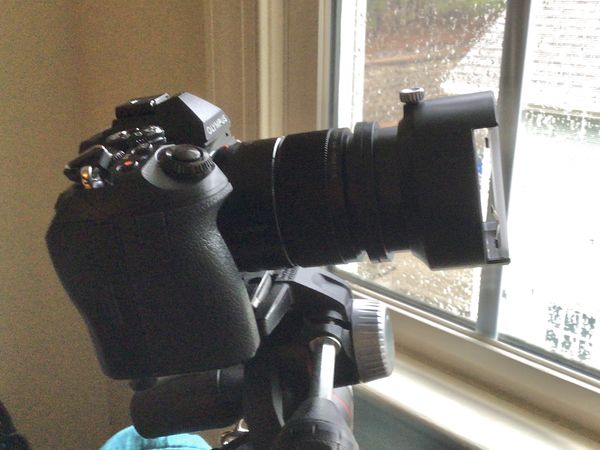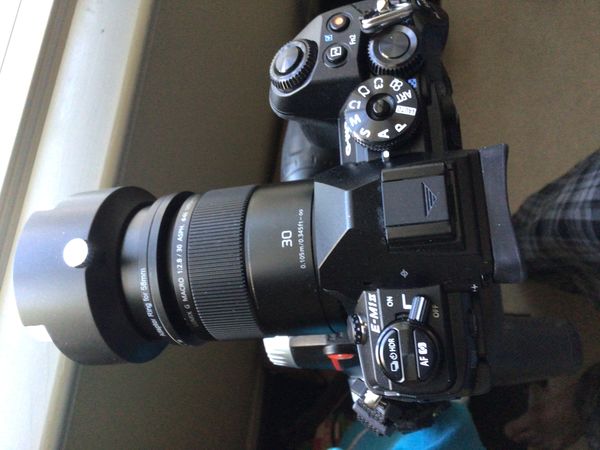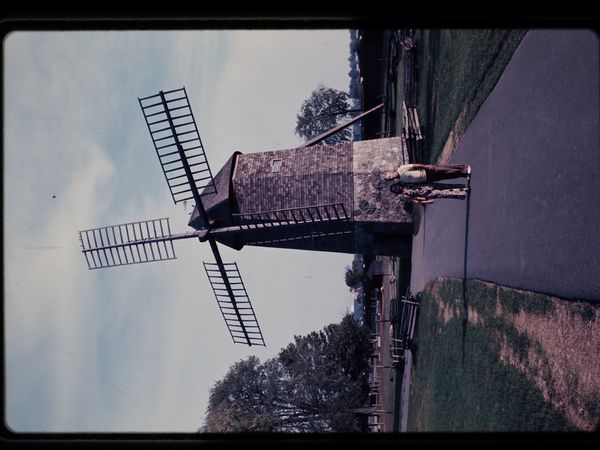35 mm scanning vs macro copying
Feb 20, 2021 21:29:32 #
Feb 20, 2021 21:54:22 #
Hanson wrote:
Please kindly explain what specifically are in front of the 45 mm lens?
Same as the earlier post about the 60 Zuiko:
46-52mm ring
Ancient Nikon “K” macro tubes
Nikon ES-1 slide holder
The blue thing is just my focus target.
The Nikon “K” manual macro tube set very commonly sells for about $15 on eBay, always a few on offer. Or post a “wanted” in the uhh classified listings. Maybe someone will give it away for barely more than the postage ;-)
Feb 22, 2021 14:50:04 #
As a supplement to my earlier comment on this post, I thought I’d send along a photo of my current rig. What you see is an Olympus OM-D-E1 Mark ii, with a LUMIX 30mm macro lens, and then the Nikon ES-2 slide and negative copier. There is no other “glass” in what you see, only some step down rings. The ES-2 comes with capability for some limited forward and backward adjustment, to adjust the distance from the front of the lens to the face of the slide to be copied. I came to this rig by trial end error at my local camera store, who sold me the ES-2 earlier, and more recently the LUMIX macro lens. In a post of a couple of months ago, I showed you my original “rig” which used the Olympus PEN-F camera with an Olympus zoom lens and a front-end macro lens by Hoya. This new rig pictured here, eliminates unnecessary glass, uses a fixed focal length macro lens, and a very capable sensor that can capture even very very underexposed slides. Good luck with your own approach, whether it be a scanner (which I tried on many slides, but then went back and re-did a number that were not so good), or something like this, which is really an optical system using the features of the camera (auto white balance to correct color, auto focus, and HDR if needed). JimR

Feb 22, 2021 15:49:32 #
Leitz
Loc: Solms
JimRPhoto wrote:
As a supplement to my earlier comment on this post... (show quote)
Wouldn't happen to have a photo with some kind of detail in it, would you?
Feb 22, 2021 16:34:11 #
JimRPhoto wrote:
As a supplement to my earlier comment on this post... (show quote)
Thank you, Jim for your detailed description.
Feb 22, 2021 16:39:41 #
JimRPhoto wrote:
As a supplement to my earlier comment on this post... (show quote)
Not seeing much details in the attached pic, but to me that looks like a 1:1 set up. Do you need extensions to do 1:2 ? When I fitted a Zuiko 30 it needed more distance to do 1:2 copies with the ES-1.
Feb 23, 2021 08:44:44 #
Reply to Leith, Hanson and UserID: Here is a cropped and lightened edit of the prior photo. It is a 1:1 setup. My local camera store, Southeastern Camera in Raleigh, had both a brand new Olympus 30mm macro, and a used LUMIX 30 mm macro. I tried both at the store and went with the LUMIX because it is all metal construction, it is a fast f/2.8 lens, and it works with nothing other than stepping down to the 52mm size of the Nikon ES-2. The Nikon ES-2 slide copier comes with two different mounting rings, one about 1.5 inches long if you need it. I do not need that one, because the one you see has a thumb screw at the top, and you can shorten or extend the distance from lens to slide. Sort of built in extension tube. Also the ES-2 has two holders, one for two slides, and one for a strip of negatives. I decided to stop using the former rig, a zoom plus a front end Hoya macro adapter for three reasons: I was worried about the repeated side to side pressure on the extended zoom lens as you insert the holder and then move it; wanted less glass; wanted a faster lens. This setup using a remote release minimizes any vibration (there is no mirror in the Olympus 4/3 cameras) and is pretty fast to operate. Hope this helps. JimR

Feb 23, 2021 08:47:09 #
Sorry it is a reply to Leitz (autocorrect misspelled it just now) Hanson and UserID. Also, went with a new photo for clarity.
Feb 23, 2021 10:00:54 #
JimRPhoto wrote:
Reply to Leith, Hanson and UserID: Here is a crop... (show quote)
Jim, just to clarify, this gives you a true 1:1 portion (17.3mm x 13mm) of the original, so you can crop a small portion of a slide or negative? Is the thing adjustable to about 1:4, so you can copy the larger 36mm x 24mm area a full slide or negative?
I have that same lens, so this rig is VERY interesting to me.
Feb 23, 2021 15:02:10 #
Reply to Burkphoto. I am showing an actual unedited digital photo of an old slide. It is a full size 35 mm slide. Using the thumbscrew at the top of my ES-2 slide copier, you can adjust the distance from the front of the lens to the plane of the slide. The autofocus works every time. You can slightly crop if you want to. However, the slide holder is sized for a standard 35 mm slide mount. I did copy some old half-frame Minolta 16mm camera slides, but they were mounted in the standard 35 mm slide mount. If I have not answered your question, please feel free to PM me. Hope this helps. JimR

Feb 24, 2021 00:57:03 #
IDguy
Loc: Idaho
Got the Kodak scanner device yesterday. As noted it is made of cardboard. But it works fine.
Kodak wants an outrageous price for their App. Plus it doesn’t put images directly into your photos. It might help transferring images to computer but I’ll try free Google App instead.
Kodak wants an outrageous price for their App. Plus it doesn’t put images directly into your photos. It might help transferring images to computer but I’ll try free Google App instead.
Feb 25, 2021 12:50:04 #
IDguy
Loc: Idaho
IDguy wrote:
Alternative:
I tested the Kodak thing. I do not recommend it. Mine is headed back to Amazon.
1. It is cardboard. The sales page says that and it is good quality cardboard but its longevity is doubtful.
2. The Kodak App to use it is a subscription service...$6/mo or $30/yr.
3. The scans go to their Web site so you have to go through an exercise to download a zip file of them.
4. The scan quality is unacceptable.
Fortunately I have a Brookstone scanner that does much better. It is much slower to use but worth the extra effort.
Feb 27, 2021 18:11:19 #
IDguy
Loc: Idaho
IDguy wrote:
I tested the Kodak thing. I do not recommend it. M... (show quote)
Got a bunch my son had scanned with the Brookstone. Terrible quality.
Looked at the Nikon ES 2. With the needed lens it is more than I want to spend. I don’t need another lens.
So I found my slide projector. It still works and, as I suspected, slides are much better than scans. So I plan to set up my camera on tripod with good lens. Now searching for screen but found one at Walmart for $10 if I can’t find it.
Feb 28, 2021 04:42:34 #
Hanson wrote:
I have a very limited number of 35 mm negatives and slides to be digitalized. Would like to hear any comments on which method renders better result: Epson V600 scanning versus copying with a macro lens (1:1).
I've done it three ways - with a lens, a flatbed scanner with backlight (Canon Coolscan 9000F), and dedicated film scanners - Minolta Dimage IV, and a Nikon Coolscan 5000 ED - this list is ranked from worst to best. Needless to say my results might be better if I used a 50mp camera for the camera/lens method, but I used film camera, and later a 10mp digital and the results did not compare. My impression was that field curvature, a characteristic of every lens, is a factor - even those that are corrected for such. You also have to deal with other aberrations and lens faults - also common to all lenses, as well as lighting inconsistencies. The flat bed scanner was an improvement, but the Dimage was even better, with the Coolscan clearly the best.
If you only have a small number of images, send them out and have them done professionally. That's what I ended up doing.
Feb 28, 2021 09:16:22 #
IDguy
Loc: Idaho
Gene51 wrote:
I've done it three ways - with a lens, a flatbed s... (show quote)
Unfortunately I have a large number of slides. I don’t plan to digitize all, though. The $20 light table is a huge help on sorting.
If you want to reply, then register here. Registration is free and your account is created instantly, so you can post right away.


